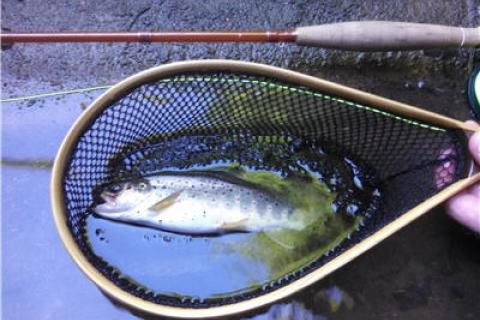
After catching a smattering of six- to eight-inch wild brown trout, the sixteen incher looked like a salmon when it came out from behind a submerged tree trunk and inhaled the nymph. A second later the seven-foot fiberglass fly rod was bent in a deep bend, one that could be felt the whole way into the handle.
 |
| Fberglass fly rods load slower, requiring the angler to slow down his or her casting stroke, i.e. you feel them "work." |
Fiberglass fly rods – like Redington’s Butter Stick – are experiencing a significant resurgence during the last few years. I suppose part of this is nostalgia-related, particularly for those of us whose fly fishing teeth were cut on fiberglass rods (mine in the 1960s and ‘70s on an eight-foot Fenwick). But fiberglass fly rods serve more of a purpose than a simple cast down memory lane.
The Casting Stroke
Whereas modern graphite rods tend to be fast and stiff, fiberglass ones are slower and softer. While the inherent characteristics of graphite has the potential to produce rods capable of long casts – as well as extreme light weight -- its stiffness requires the caster to work moderately hard to load the rod. This is particularly true of the stiff, extra-fast rods so much in vogue today. In general, fiberglass fly rods load slower, requiring the angler to slow down his or her casting stroke so the rod can do its thing. As such, the casting aspects of fiberglass rods tend to have a more personal quality to them, i.e. you feel them “work.”
The Casting Distance
In most trout fishing situations -- particularly in small stream settings -- long casts are unnecessary (or impossible), so giving up potential casting distance when fishing fiberglass rather than graphite isn’t a significant sacrifice. It’s not surprising that many current fiberglass fly rod makers include many shorter models in the six- to seven-foot range designed to throw 2- to 4-weight lines. Redington’s Butter Stick has four rods within this range. Such rods are a relative joy to fish in tight quarters, and make streamside navigation much easier. My seven-foot, 3-weight is fully capable of casting a 4-weight line; it handles the small stuff great, and has no problem with a weighted Woolly Bugger flies when conditions warrant such use.
Learn more about choosing a new fly rod on Bass Pro 1Source.
- 6069 views

